Staging an Event like Australian Open: A Methodical Approach to Event Management
VerifiedAdded on 2019/10/30
|15
|3557
|181
Report
AI Summary
The assignment content emphasizes the importance of event management, which requires careful planning, sustainability, cost reduction, and partnerships with sponsors and broadcasters. The report highlights the need for meticulous planning to avoid loopholes, taking care of the players' needs, and being socially and environmentally responsible. The organizers are advised to reduce costs by using eco-friendly materials, scheduling live broadcasts conveniently, and hosting the tournament in a way that causes no harm.
Contribute Materials
Your contribution can guide someone’s learning journey. Share your
documents today.
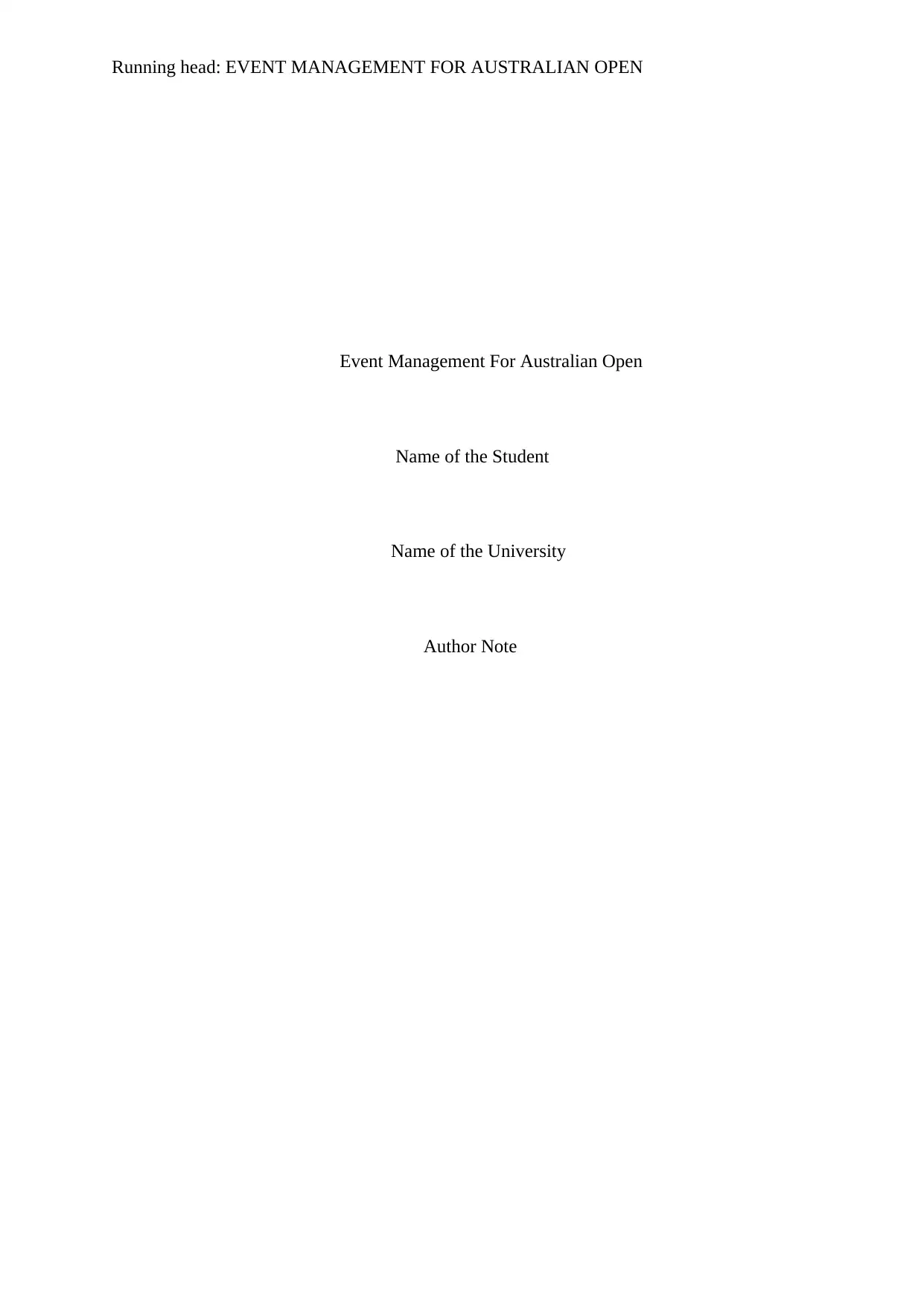
Running head: EVENT MANAGEMENT FOR AUSTRALIAN OPEN
Event Management For Australian Open
Name of the Student
Name of the University
Author Note
Event Management For Australian Open
Name of the Student
Name of the University
Author Note
Secure Best Marks with AI Grader
Need help grading? Try our AI Grader for instant feedback on your assignments.
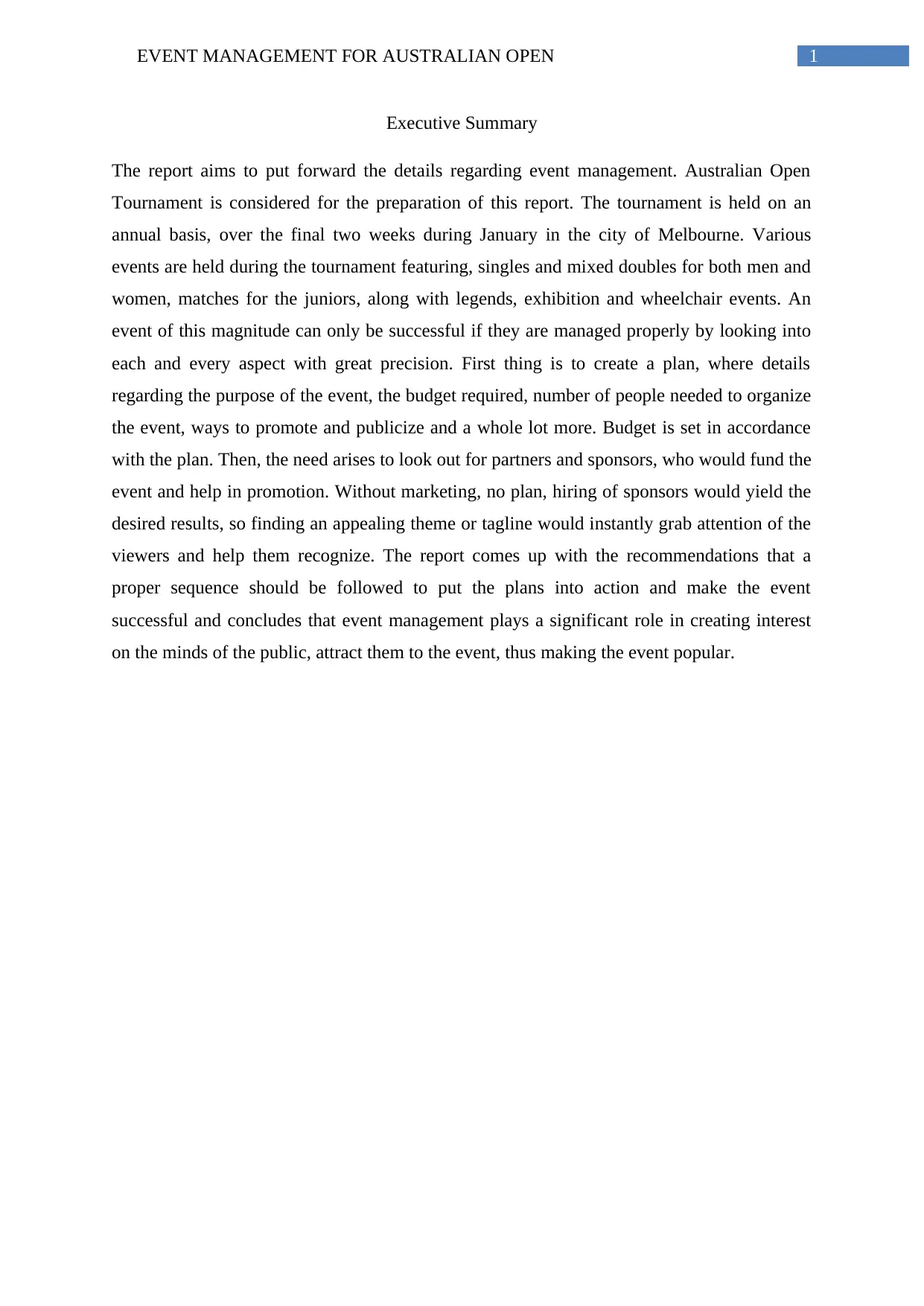
1EVENT MANAGEMENT FOR AUSTRALIAN OPEN
Executive Summary
The report aims to put forward the details regarding event management. Australian Open
Tournament is considered for the preparation of this report. The tournament is held on an
annual basis, over the final two weeks during January in the city of Melbourne. Various
events are held during the tournament featuring, singles and mixed doubles for both men and
women, matches for the juniors, along with legends, exhibition and wheelchair events. An
event of this magnitude can only be successful if they are managed properly by looking into
each and every aspect with great precision. First thing is to create a plan, where details
regarding the purpose of the event, the budget required, number of people needed to organize
the event, ways to promote and publicize and a whole lot more. Budget is set in accordance
with the plan. Then, the need arises to look out for partners and sponsors, who would fund the
event and help in promotion. Without marketing, no plan, hiring of sponsors would yield the
desired results, so finding an appealing theme or tagline would instantly grab attention of the
viewers and help them recognize. The report comes up with the recommendations that a
proper sequence should be followed to put the plans into action and make the event
successful and concludes that event management plays a significant role in creating interest
on the minds of the public, attract them to the event, thus making the event popular.
Executive Summary
The report aims to put forward the details regarding event management. Australian Open
Tournament is considered for the preparation of this report. The tournament is held on an
annual basis, over the final two weeks during January in the city of Melbourne. Various
events are held during the tournament featuring, singles and mixed doubles for both men and
women, matches for the juniors, along with legends, exhibition and wheelchair events. An
event of this magnitude can only be successful if they are managed properly by looking into
each and every aspect with great precision. First thing is to create a plan, where details
regarding the purpose of the event, the budget required, number of people needed to organize
the event, ways to promote and publicize and a whole lot more. Budget is set in accordance
with the plan. Then, the need arises to look out for partners and sponsors, who would fund the
event and help in promotion. Without marketing, no plan, hiring of sponsors would yield the
desired results, so finding an appealing theme or tagline would instantly grab attention of the
viewers and help them recognize. The report comes up with the recommendations that a
proper sequence should be followed to put the plans into action and make the event
successful and concludes that event management plays a significant role in creating interest
on the minds of the public, attract them to the event, thus making the event popular.
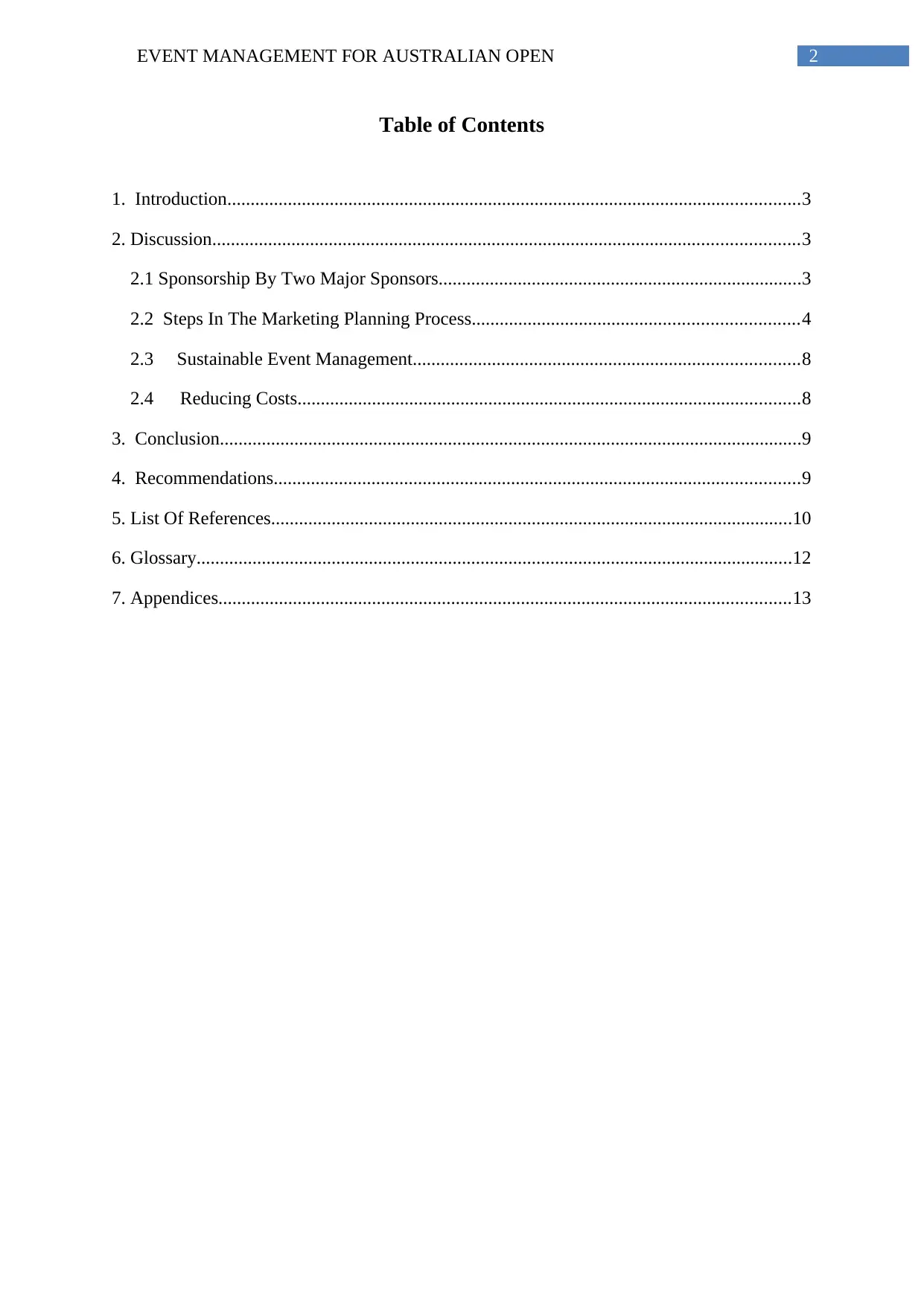
2EVENT MANAGEMENT FOR AUSTRALIAN OPEN
Table of Contents
1. Introduction...........................................................................................................................3
2. Discussion..............................................................................................................................3
2.1 Sponsorship By Two Major Sponsors..............................................................................3
2.2 Steps In The Marketing Planning Process......................................................................4
2.3 Sustainable Event Management...................................................................................8
2.4 Reducing Costs............................................................................................................8
3. Conclusion.............................................................................................................................9
4. Recommendations.................................................................................................................9
5. List Of References................................................................................................................10
6. Glossary................................................................................................................................12
7. Appendices...........................................................................................................................13
Table of Contents
1. Introduction...........................................................................................................................3
2. Discussion..............................................................................................................................3
2.1 Sponsorship By Two Major Sponsors..............................................................................3
2.2 Steps In The Marketing Planning Process......................................................................4
2.3 Sustainable Event Management...................................................................................8
2.4 Reducing Costs............................................................................................................8
3. Conclusion.............................................................................................................................9
4. Recommendations.................................................................................................................9
5. List Of References................................................................................................................10
6. Glossary................................................................................................................................12
7. Appendices...........................................................................................................................13
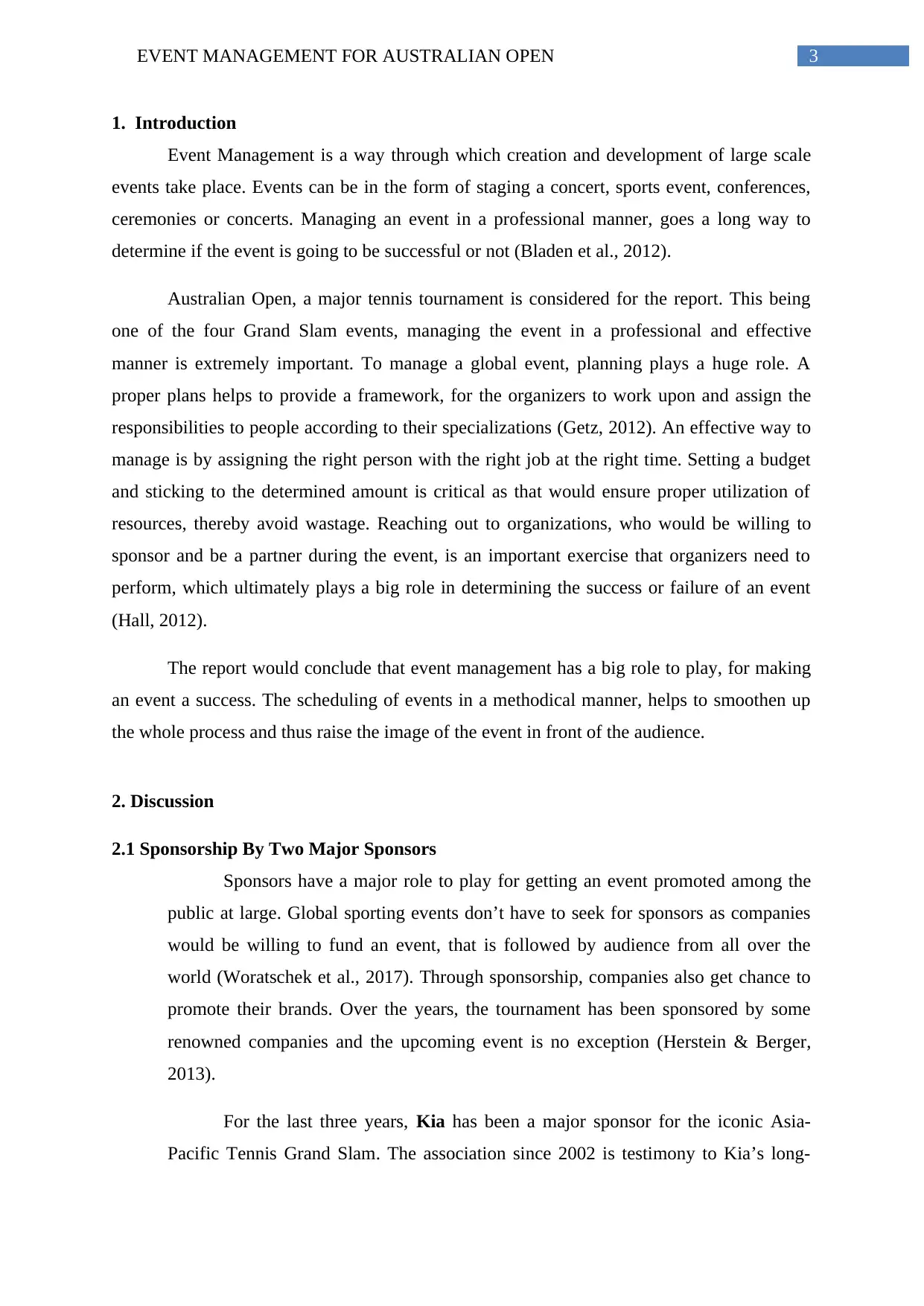
3EVENT MANAGEMENT FOR AUSTRALIAN OPEN
1. Introduction
Event Management is a way through which creation and development of large scale
events take place. Events can be in the form of staging a concert, sports event, conferences,
ceremonies or concerts. Managing an event in a professional manner, goes a long way to
determine if the event is going to be successful or not (Bladen et al., 2012).
Australian Open, a major tennis tournament is considered for the report. This being
one of the four Grand Slam events, managing the event in a professional and effective
manner is extremely important. To manage a global event, planning plays a huge role. A
proper plans helps to provide a framework, for the organizers to work upon and assign the
responsibilities to people according to their specializations (Getz, 2012). An effective way to
manage is by assigning the right person with the right job at the right time. Setting a budget
and sticking to the determined amount is critical as that would ensure proper utilization of
resources, thereby avoid wastage. Reaching out to organizations, who would be willing to
sponsor and be a partner during the event, is an important exercise that organizers need to
perform, which ultimately plays a big role in determining the success or failure of an event
(Hall, 2012).
The report would conclude that event management has a big role to play, for making
an event a success. The scheduling of events in a methodical manner, helps to smoothen up
the whole process and thus raise the image of the event in front of the audience.
2. Discussion
2.1 Sponsorship By Two Major Sponsors
Sponsors have a major role to play for getting an event promoted among the
public at large. Global sporting events don’t have to seek for sponsors as companies
would be willing to fund an event, that is followed by audience from all over the
world (Woratschek et al., 2017). Through sponsorship, companies also get chance to
promote their brands. Over the years, the tournament has been sponsored by some
renowned companies and the upcoming event is no exception (Herstein & Berger,
2013).
For the last three years, Kia has been a major sponsor for the iconic Asia-
Pacific Tennis Grand Slam. The association since 2002 is testimony to Kia’s long-
1. Introduction
Event Management is a way through which creation and development of large scale
events take place. Events can be in the form of staging a concert, sports event, conferences,
ceremonies or concerts. Managing an event in a professional manner, goes a long way to
determine if the event is going to be successful or not (Bladen et al., 2012).
Australian Open, a major tennis tournament is considered for the report. This being
one of the four Grand Slam events, managing the event in a professional and effective
manner is extremely important. To manage a global event, planning plays a huge role. A
proper plans helps to provide a framework, for the organizers to work upon and assign the
responsibilities to people according to their specializations (Getz, 2012). An effective way to
manage is by assigning the right person with the right job at the right time. Setting a budget
and sticking to the determined amount is critical as that would ensure proper utilization of
resources, thereby avoid wastage. Reaching out to organizations, who would be willing to
sponsor and be a partner during the event, is an important exercise that organizers need to
perform, which ultimately plays a big role in determining the success or failure of an event
(Hall, 2012).
The report would conclude that event management has a big role to play, for making
an event a success. The scheduling of events in a methodical manner, helps to smoothen up
the whole process and thus raise the image of the event in front of the audience.
2. Discussion
2.1 Sponsorship By Two Major Sponsors
Sponsors have a major role to play for getting an event promoted among the
public at large. Global sporting events don’t have to seek for sponsors as companies
would be willing to fund an event, that is followed by audience from all over the
world (Woratschek et al., 2017). Through sponsorship, companies also get chance to
promote their brands. Over the years, the tournament has been sponsored by some
renowned companies and the upcoming event is no exception (Herstein & Berger,
2013).
For the last three years, Kia has been a major sponsor for the iconic Asia-
Pacific Tennis Grand Slam. The association since 2002 is testimony to Kia’s long-
Secure Best Marks with AI Grader
Need help grading? Try our AI Grader for instant feedback on your assignments.
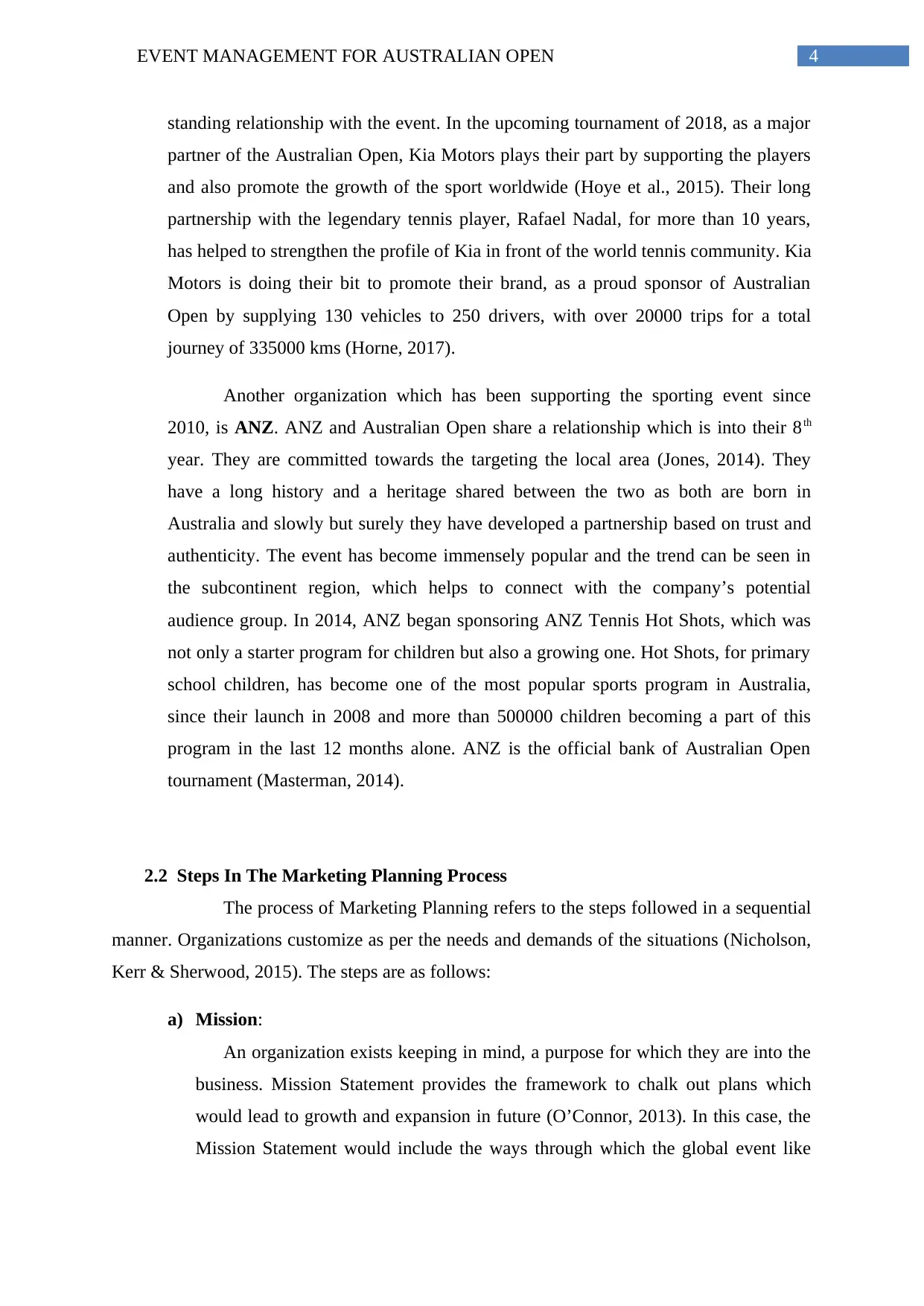
4EVENT MANAGEMENT FOR AUSTRALIAN OPEN
standing relationship with the event. In the upcoming tournament of 2018, as a major
partner of the Australian Open, Kia Motors plays their part by supporting the players
and also promote the growth of the sport worldwide (Hoye et al., 2015). Their long
partnership with the legendary tennis player, Rafael Nadal, for more than 10 years,
has helped to strengthen the profile of Kia in front of the world tennis community. Kia
Motors is doing their bit to promote their brand, as a proud sponsor of Australian
Open by supplying 130 vehicles to 250 drivers, with over 20000 trips for a total
journey of 335000 kms (Horne, 2017).
Another organization which has been supporting the sporting event since
2010, is ANZ. ANZ and Australian Open share a relationship which is into their 8th
year. They are committed towards the targeting the local area (Jones, 2014). They
have a long history and a heritage shared between the two as both are born in
Australia and slowly but surely they have developed a partnership based on trust and
authenticity. The event has become immensely popular and the trend can be seen in
the subcontinent region, which helps to connect with the company’s potential
audience group. In 2014, ANZ began sponsoring ANZ Tennis Hot Shots, which was
not only a starter program for children but also a growing one. Hot Shots, for primary
school children, has become one of the most popular sports program in Australia,
since their launch in 2008 and more than 500000 children becoming a part of this
program in the last 12 months alone. ANZ is the official bank of Australian Open
tournament (Masterman, 2014).
2.2 Steps In The Marketing Planning Process
The process of Marketing Planning refers to the steps followed in a sequential
manner. Organizations customize as per the needs and demands of the situations (Nicholson,
Kerr & Sherwood, 2015). The steps are as follows:
a) Mission:
An organization exists keeping in mind, a purpose for which they are into the
business. Mission Statement provides the framework to chalk out plans which
would lead to growth and expansion in future (O’Connor, 2013). In this case, the
Mission Statement would include the ways through which the global event like
standing relationship with the event. In the upcoming tournament of 2018, as a major
partner of the Australian Open, Kia Motors plays their part by supporting the players
and also promote the growth of the sport worldwide (Hoye et al., 2015). Their long
partnership with the legendary tennis player, Rafael Nadal, for more than 10 years,
has helped to strengthen the profile of Kia in front of the world tennis community. Kia
Motors is doing their bit to promote their brand, as a proud sponsor of Australian
Open by supplying 130 vehicles to 250 drivers, with over 20000 trips for a total
journey of 335000 kms (Horne, 2017).
Another organization which has been supporting the sporting event since
2010, is ANZ. ANZ and Australian Open share a relationship which is into their 8th
year. They are committed towards the targeting the local area (Jones, 2014). They
have a long history and a heritage shared between the two as both are born in
Australia and slowly but surely they have developed a partnership based on trust and
authenticity. The event has become immensely popular and the trend can be seen in
the subcontinent region, which helps to connect with the company’s potential
audience group. In 2014, ANZ began sponsoring ANZ Tennis Hot Shots, which was
not only a starter program for children but also a growing one. Hot Shots, for primary
school children, has become one of the most popular sports program in Australia,
since their launch in 2008 and more than 500000 children becoming a part of this
program in the last 12 months alone. ANZ is the official bank of Australian Open
tournament (Masterman, 2014).
2.2 Steps In The Marketing Planning Process
The process of Marketing Planning refers to the steps followed in a sequential
manner. Organizations customize as per the needs and demands of the situations (Nicholson,
Kerr & Sherwood, 2015). The steps are as follows:
a) Mission:
An organization exists keeping in mind, a purpose for which they are into the
business. Mission Statement provides the framework to chalk out plans which
would lead to growth and expansion in future (O’Connor, 2013). In this case, the
Mission Statement would include the ways through which the global event like
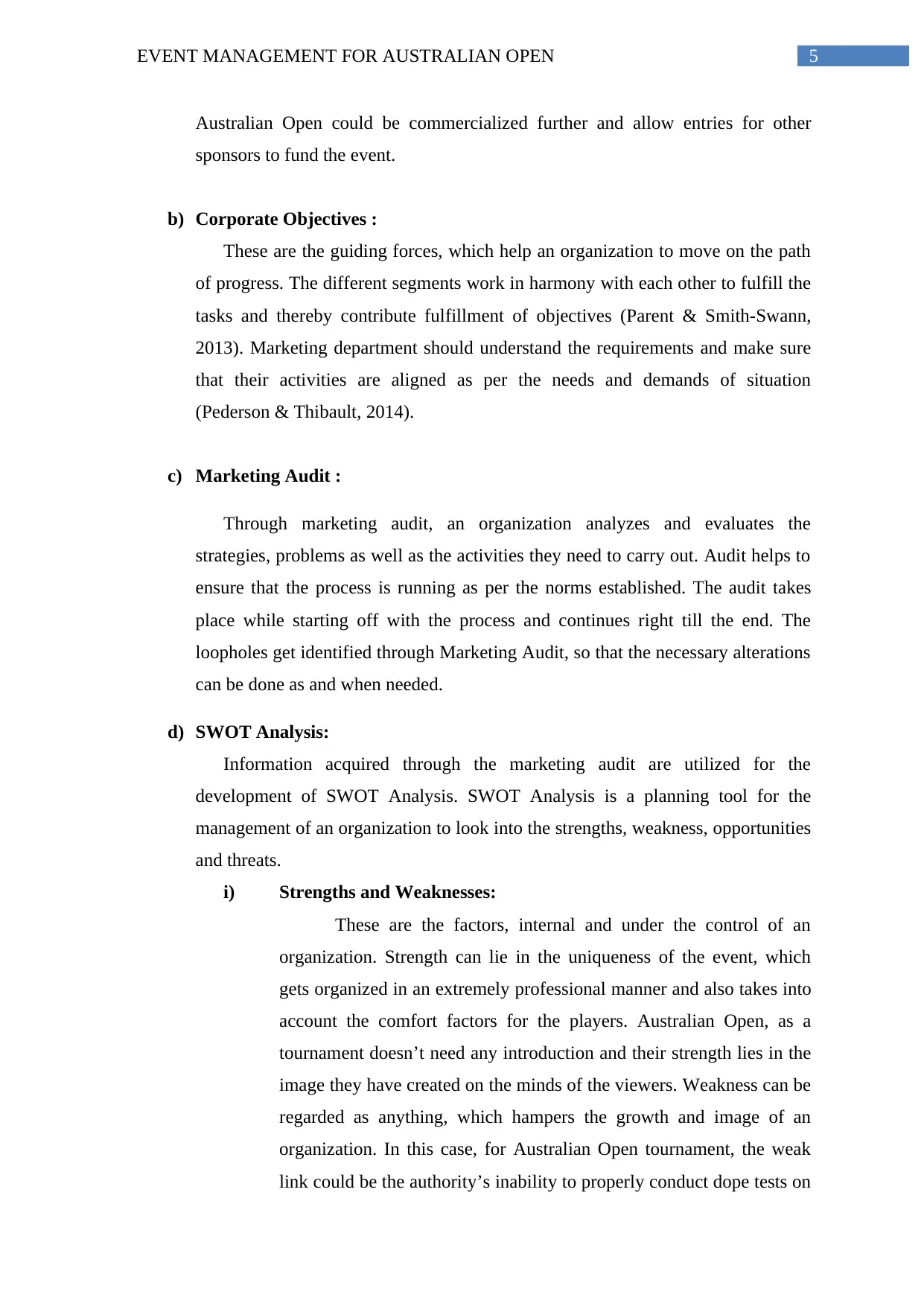
5EVENT MANAGEMENT FOR AUSTRALIAN OPEN
Australian Open could be commercialized further and allow entries for other
sponsors to fund the event.
b) Corporate Objectives :
These are the guiding forces, which help an organization to move on the path
of progress. The different segments work in harmony with each other to fulfill the
tasks and thereby contribute fulfillment of objectives (Parent & Smith-Swann,
2013). Marketing department should understand the requirements and make sure
that their activities are aligned as per the needs and demands of situation
(Pederson & Thibault, 2014).
c) Marketing Audit :
Through marketing audit, an organization analyzes and evaluates the
strategies, problems as well as the activities they need to carry out. Audit helps to
ensure that the process is running as per the norms established. The audit takes
place while starting off with the process and continues right till the end. The
loopholes get identified through Marketing Audit, so that the necessary alterations
can be done as and when needed.
d) SWOT Analysis:
Information acquired through the marketing audit are utilized for the
development of SWOT Analysis. SWOT Analysis is a planning tool for the
management of an organization to look into the strengths, weakness, opportunities
and threats.
i) Strengths and Weaknesses:
These are the factors, internal and under the control of an
organization. Strength can lie in the uniqueness of the event, which
gets organized in an extremely professional manner and also takes into
account the comfort factors for the players. Australian Open, as a
tournament doesn’t need any introduction and their strength lies in the
image they have created on the minds of the viewers. Weakness can be
regarded as anything, which hampers the growth and image of an
organization. In this case, for Australian Open tournament, the weak
link could be the authority’s inability to properly conduct dope tests on
Australian Open could be commercialized further and allow entries for other
sponsors to fund the event.
b) Corporate Objectives :
These are the guiding forces, which help an organization to move on the path
of progress. The different segments work in harmony with each other to fulfill the
tasks and thereby contribute fulfillment of objectives (Parent & Smith-Swann,
2013). Marketing department should understand the requirements and make sure
that their activities are aligned as per the needs and demands of situation
(Pederson & Thibault, 2014).
c) Marketing Audit :
Through marketing audit, an organization analyzes and evaluates the
strategies, problems as well as the activities they need to carry out. Audit helps to
ensure that the process is running as per the norms established. The audit takes
place while starting off with the process and continues right till the end. The
loopholes get identified through Marketing Audit, so that the necessary alterations
can be done as and when needed.
d) SWOT Analysis:
Information acquired through the marketing audit are utilized for the
development of SWOT Analysis. SWOT Analysis is a planning tool for the
management of an organization to look into the strengths, weakness, opportunities
and threats.
i) Strengths and Weaknesses:
These are the factors, internal and under the control of an
organization. Strength can lie in the uniqueness of the event, which
gets organized in an extremely professional manner and also takes into
account the comfort factors for the players. Australian Open, as a
tournament doesn’t need any introduction and their strength lies in the
image they have created on the minds of the viewers. Weakness can be
regarded as anything, which hampers the growth and image of an
organization. In this case, for Australian Open tournament, the weak
link could be the authority’s inability to properly conduct dope tests on
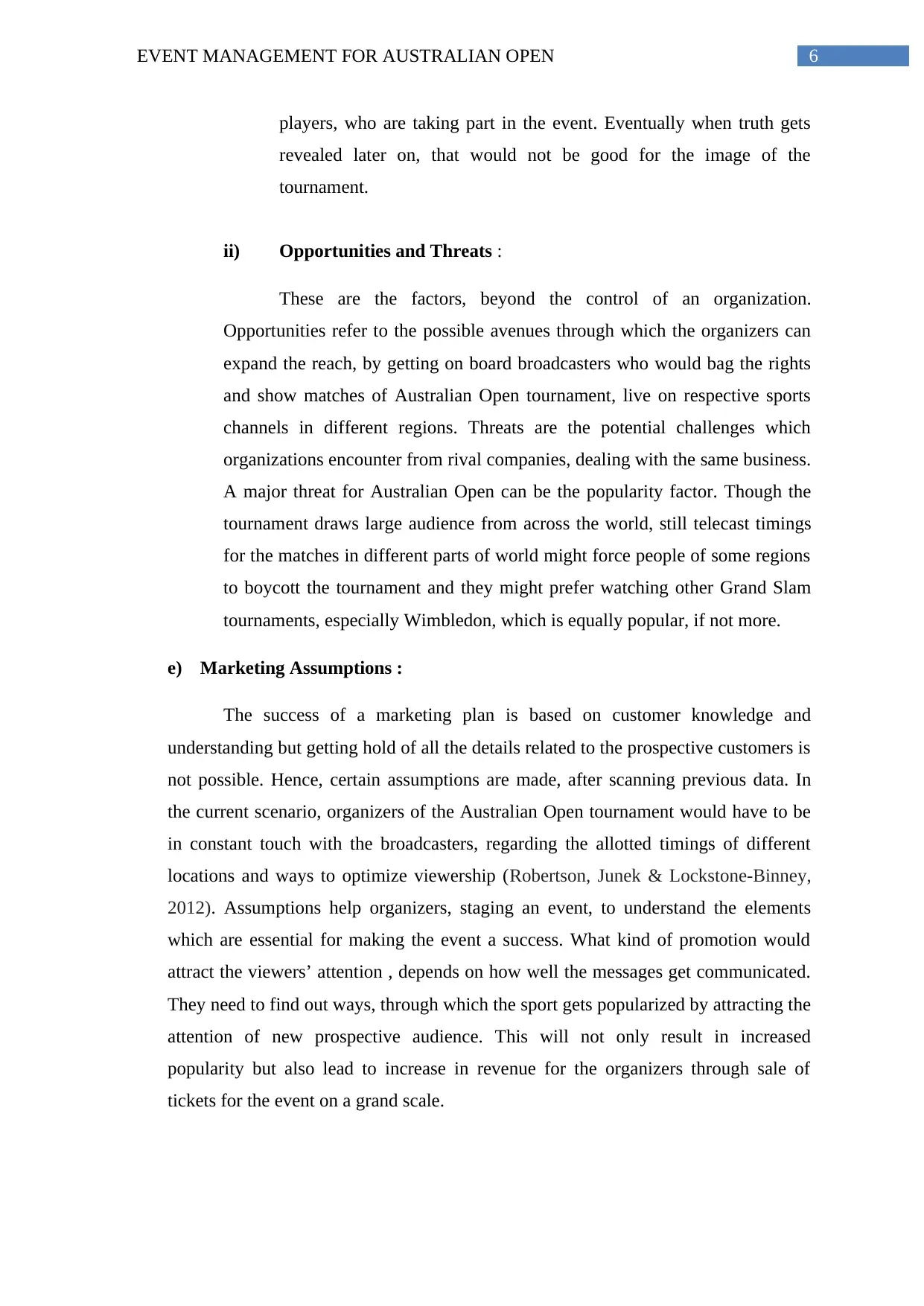
6EVENT MANAGEMENT FOR AUSTRALIAN OPEN
players, who are taking part in the event. Eventually when truth gets
revealed later on, that would not be good for the image of the
tournament.
ii) Opportunities and Threats :
These are the factors, beyond the control of an organization.
Opportunities refer to the possible avenues through which the organizers can
expand the reach, by getting on board broadcasters who would bag the rights
and show matches of Australian Open tournament, live on respective sports
channels in different regions. Threats are the potential challenges which
organizations encounter from rival companies, dealing with the same business.
A major threat for Australian Open can be the popularity factor. Though the
tournament draws large audience from across the world, still telecast timings
for the matches in different parts of world might force people of some regions
to boycott the tournament and they might prefer watching other Grand Slam
tournaments, especially Wimbledon, which is equally popular, if not more.
e) Marketing Assumptions :
The success of a marketing plan is based on customer knowledge and
understanding but getting hold of all the details related to the prospective customers is
not possible. Hence, certain assumptions are made, after scanning previous data. In
the current scenario, organizers of the Australian Open tournament would have to be
in constant touch with the broadcasters, regarding the allotted timings of different
locations and ways to optimize viewership (Robertson, Junek & Lockstone-Binney,
2012). Assumptions help organizers, staging an event, to understand the elements
which are essential for making the event a success. What kind of promotion would
attract the viewers’ attention , depends on how well the messages get communicated.
They need to find out ways, through which the sport gets popularized by attracting the
attention of new prospective audience. This will not only result in increased
popularity but also lead to increase in revenue for the organizers through sale of
tickets for the event on a grand scale.
players, who are taking part in the event. Eventually when truth gets
revealed later on, that would not be good for the image of the
tournament.
ii) Opportunities and Threats :
These are the factors, beyond the control of an organization.
Opportunities refer to the possible avenues through which the organizers can
expand the reach, by getting on board broadcasters who would bag the rights
and show matches of Australian Open tournament, live on respective sports
channels in different regions. Threats are the potential challenges which
organizations encounter from rival companies, dealing with the same business.
A major threat for Australian Open can be the popularity factor. Though the
tournament draws large audience from across the world, still telecast timings
for the matches in different parts of world might force people of some regions
to boycott the tournament and they might prefer watching other Grand Slam
tournaments, especially Wimbledon, which is equally popular, if not more.
e) Marketing Assumptions :
The success of a marketing plan is based on customer knowledge and
understanding but getting hold of all the details related to the prospective customers is
not possible. Hence, certain assumptions are made, after scanning previous data. In
the current scenario, organizers of the Australian Open tournament would have to be
in constant touch with the broadcasters, regarding the allotted timings of different
locations and ways to optimize viewership (Robertson, Junek & Lockstone-Binney,
2012). Assumptions help organizers, staging an event, to understand the elements
which are essential for making the event a success. What kind of promotion would
attract the viewers’ attention , depends on how well the messages get communicated.
They need to find out ways, through which the sport gets popularized by attracting the
attention of new prospective audience. This will not only result in increased
popularity but also lead to increase in revenue for the organizers through sale of
tickets for the event on a grand scale.
Paraphrase This Document
Need a fresh take? Get an instant paraphrase of this document with our AI Paraphraser
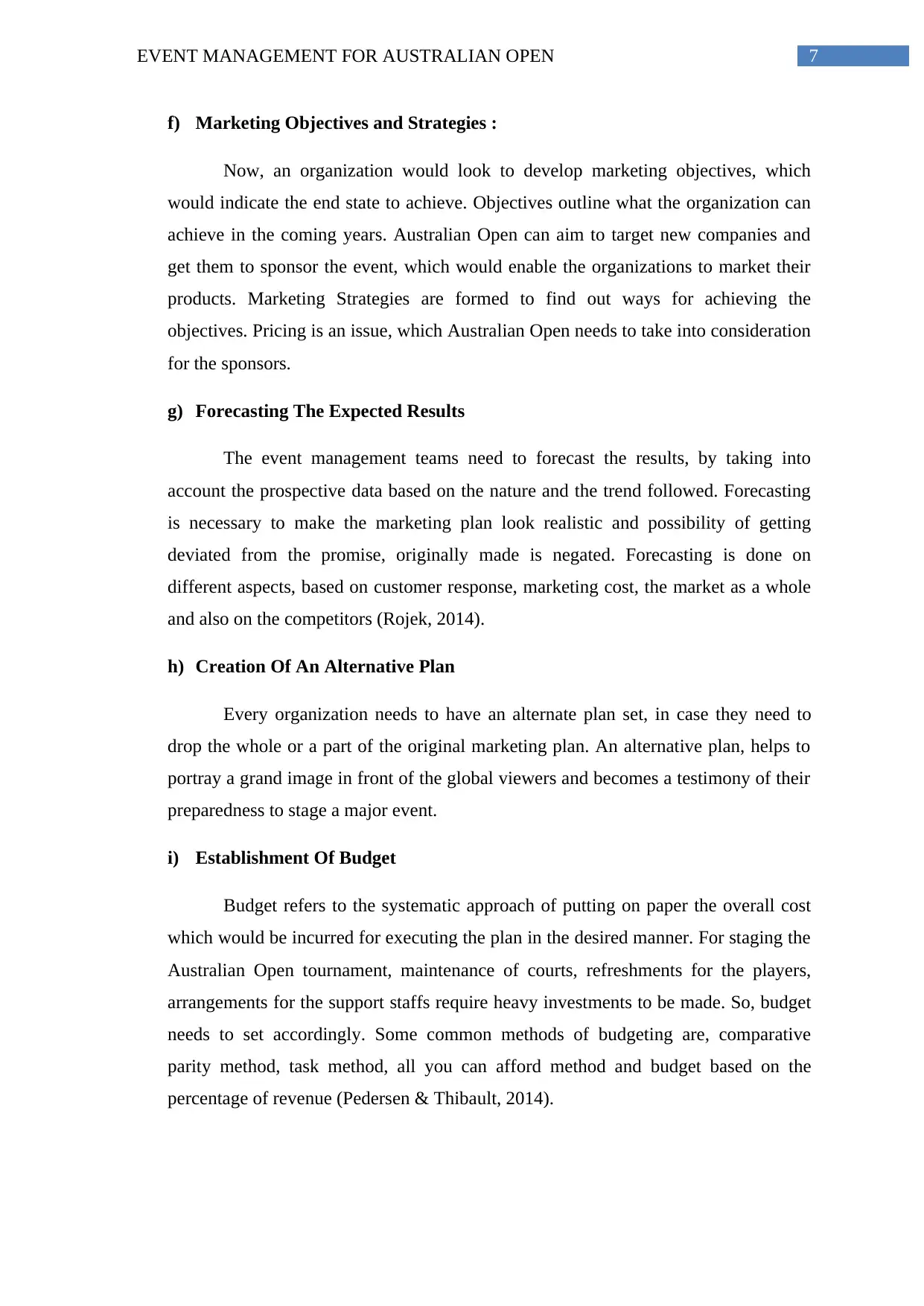
7EVENT MANAGEMENT FOR AUSTRALIAN OPEN
f) Marketing Objectives and Strategies :
Now, an organization would look to develop marketing objectives, which
would indicate the end state to achieve. Objectives outline what the organization can
achieve in the coming years. Australian Open can aim to target new companies and
get them to sponsor the event, which would enable the organizations to market their
products. Marketing Strategies are formed to find out ways for achieving the
objectives. Pricing is an issue, which Australian Open needs to take into consideration
for the sponsors.
g) Forecasting The Expected Results
The event management teams need to forecast the results, by taking into
account the prospective data based on the nature and the trend followed. Forecasting
is necessary to make the marketing plan look realistic and possibility of getting
deviated from the promise, originally made is negated. Forecasting is done on
different aspects, based on customer response, marketing cost, the market as a whole
and also on the competitors (Rojek, 2014).
h) Creation Of An Alternative Plan
Every organization needs to have an alternate plan set, in case they need to
drop the whole or a part of the original marketing plan. An alternative plan, helps to
portray a grand image in front of the global viewers and becomes a testimony of their
preparedness to stage a major event.
i) Establishment Of Budget
Budget refers to the systematic approach of putting on paper the overall cost
which would be incurred for executing the plan in the desired manner. For staging the
Australian Open tournament, maintenance of courts, refreshments for the players,
arrangements for the support staffs require heavy investments to be made. So, budget
needs to set accordingly. Some common methods of budgeting are, comparative
parity method, task method, all you can afford method and budget based on the
percentage of revenue (Pedersen & Thibault, 2014).
f) Marketing Objectives and Strategies :
Now, an organization would look to develop marketing objectives, which
would indicate the end state to achieve. Objectives outline what the organization can
achieve in the coming years. Australian Open can aim to target new companies and
get them to sponsor the event, which would enable the organizations to market their
products. Marketing Strategies are formed to find out ways for achieving the
objectives. Pricing is an issue, which Australian Open needs to take into consideration
for the sponsors.
g) Forecasting The Expected Results
The event management teams need to forecast the results, by taking into
account the prospective data based on the nature and the trend followed. Forecasting
is necessary to make the marketing plan look realistic and possibility of getting
deviated from the promise, originally made is negated. Forecasting is done on
different aspects, based on customer response, marketing cost, the market as a whole
and also on the competitors (Rojek, 2014).
h) Creation Of An Alternative Plan
Every organization needs to have an alternate plan set, in case they need to
drop the whole or a part of the original marketing plan. An alternative plan, helps to
portray a grand image in front of the global viewers and becomes a testimony of their
preparedness to stage a major event.
i) Establishment Of Budget
Budget refers to the systematic approach of putting on paper the overall cost
which would be incurred for executing the plan in the desired manner. For staging the
Australian Open tournament, maintenance of courts, refreshments for the players,
arrangements for the support staffs require heavy investments to be made. So, budget
needs to set accordingly. Some common methods of budgeting are, comparative
parity method, task method, all you can afford method and budget based on the
percentage of revenue (Pedersen & Thibault, 2014).
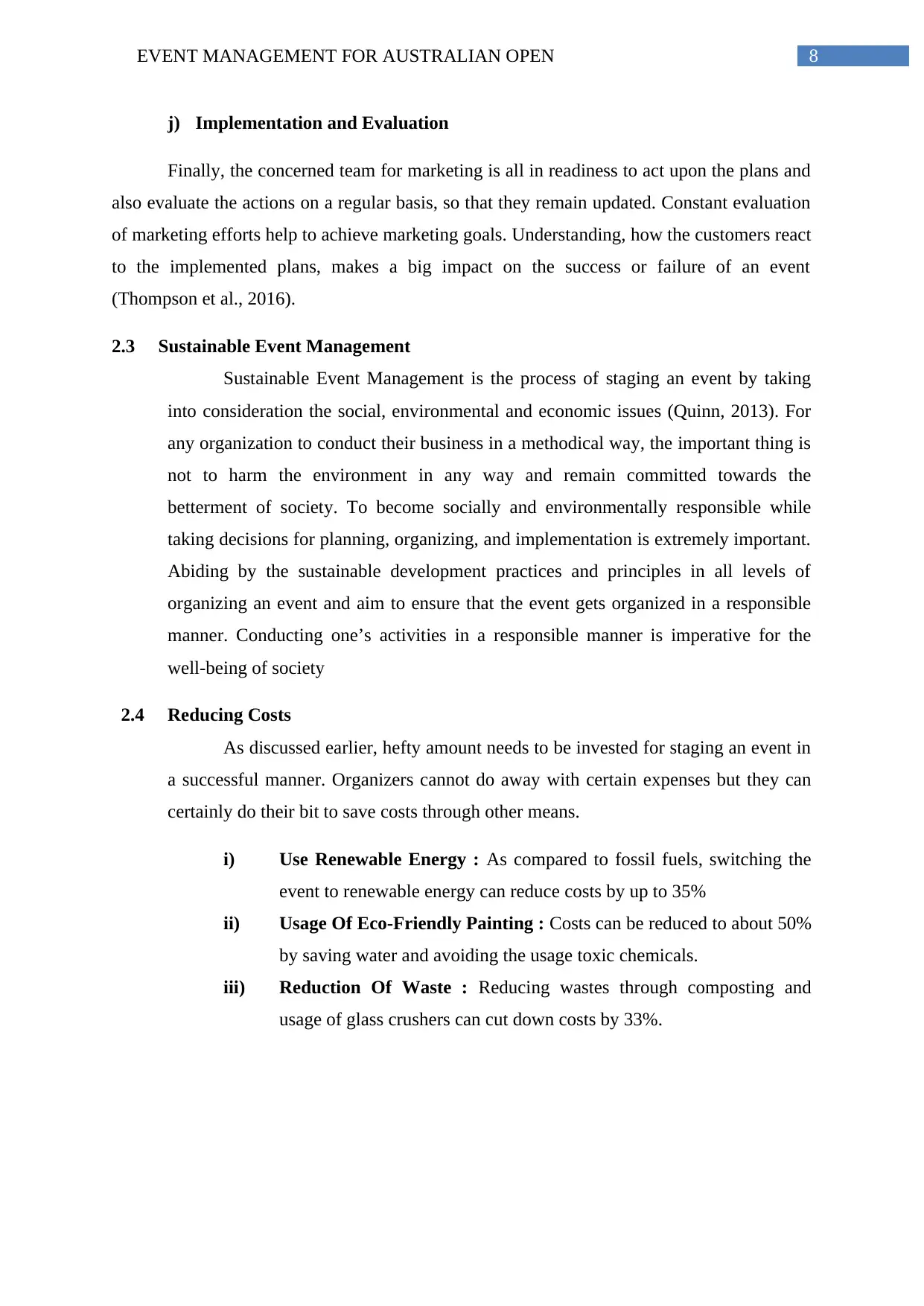
8EVENT MANAGEMENT FOR AUSTRALIAN OPEN
j) Implementation and Evaluation
Finally, the concerned team for marketing is all in readiness to act upon the plans and
also evaluate the actions on a regular basis, so that they remain updated. Constant evaluation
of marketing efforts help to achieve marketing goals. Understanding, how the customers react
to the implemented plans, makes a big impact on the success or failure of an event
(Thompson et al., 2016).
2.3 Sustainable Event Management
Sustainable Event Management is the process of staging an event by taking
into consideration the social, environmental and economic issues (Quinn, 2013). For
any organization to conduct their business in a methodical way, the important thing is
not to harm the environment in any way and remain committed towards the
betterment of society. To become socially and environmentally responsible while
taking decisions for planning, organizing, and implementation is extremely important.
Abiding by the sustainable development practices and principles in all levels of
organizing an event and aim to ensure that the event gets organized in a responsible
manner. Conducting one’s activities in a responsible manner is imperative for the
well-being of society
2.4 Reducing Costs
As discussed earlier, hefty amount needs to be invested for staging an event in
a successful manner. Organizers cannot do away with certain expenses but they can
certainly do their bit to save costs through other means.
i) Use Renewable Energy : As compared to fossil fuels, switching the
event to renewable energy can reduce costs by up to 35%
ii) Usage Of Eco-Friendly Painting : Costs can be reduced to about 50%
by saving water and avoiding the usage toxic chemicals.
iii) Reduction Of Waste : Reducing wastes through composting and
usage of glass crushers can cut down costs by 33%.
j) Implementation and Evaluation
Finally, the concerned team for marketing is all in readiness to act upon the plans and
also evaluate the actions on a regular basis, so that they remain updated. Constant evaluation
of marketing efforts help to achieve marketing goals. Understanding, how the customers react
to the implemented plans, makes a big impact on the success or failure of an event
(Thompson et al., 2016).
2.3 Sustainable Event Management
Sustainable Event Management is the process of staging an event by taking
into consideration the social, environmental and economic issues (Quinn, 2013). For
any organization to conduct their business in a methodical way, the important thing is
not to harm the environment in any way and remain committed towards the
betterment of society. To become socially and environmentally responsible while
taking decisions for planning, organizing, and implementation is extremely important.
Abiding by the sustainable development practices and principles in all levels of
organizing an event and aim to ensure that the event gets organized in a responsible
manner. Conducting one’s activities in a responsible manner is imperative for the
well-being of society
2.4 Reducing Costs
As discussed earlier, hefty amount needs to be invested for staging an event in
a successful manner. Organizers cannot do away with certain expenses but they can
certainly do their bit to save costs through other means.
i) Use Renewable Energy : As compared to fossil fuels, switching the
event to renewable energy can reduce costs by up to 35%
ii) Usage Of Eco-Friendly Painting : Costs can be reduced to about 50%
by saving water and avoiding the usage toxic chemicals.
iii) Reduction Of Waste : Reducing wastes through composting and
usage of glass crushers can cut down costs by 33%.
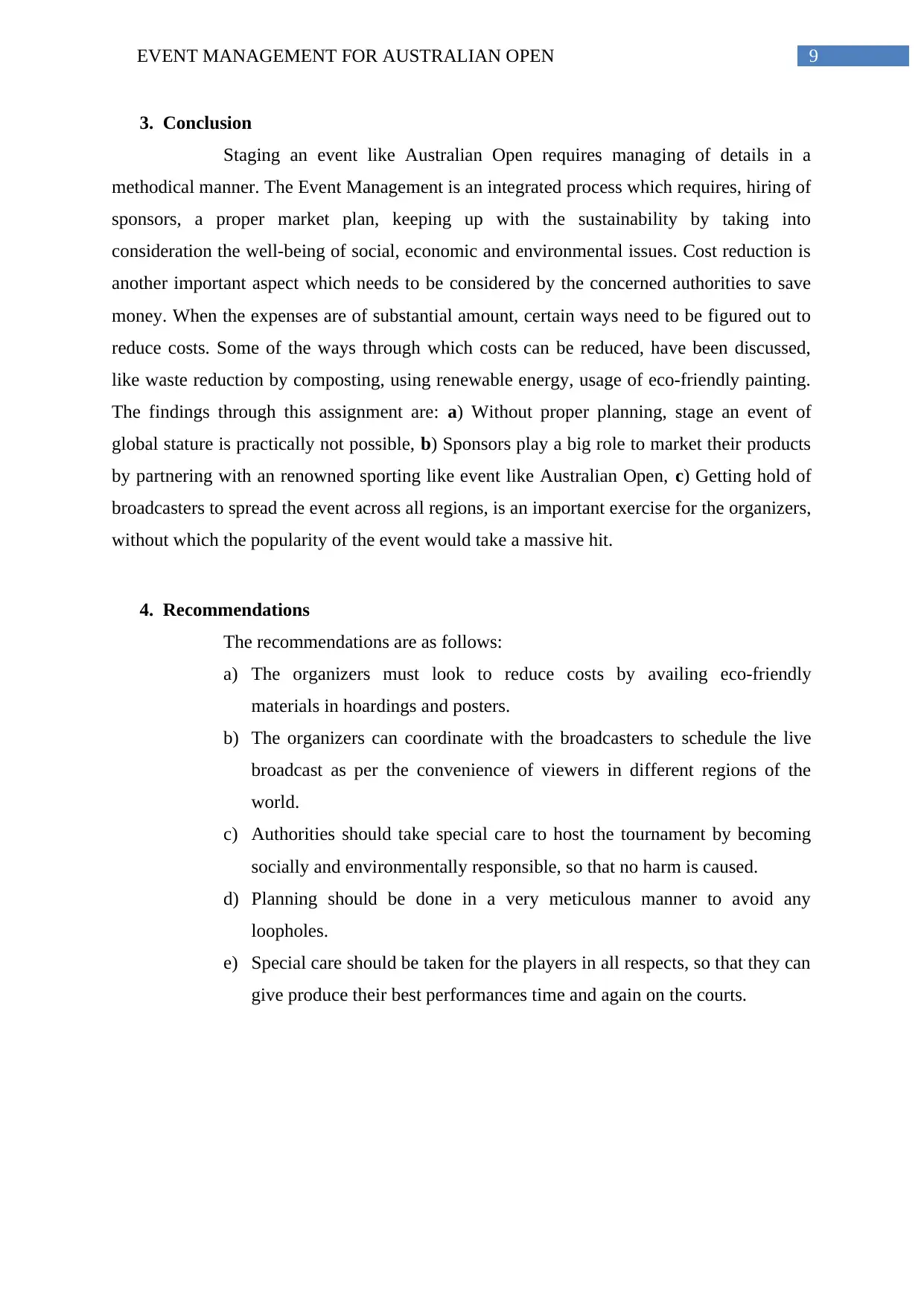
9EVENT MANAGEMENT FOR AUSTRALIAN OPEN
3. Conclusion
Staging an event like Australian Open requires managing of details in a
methodical manner. The Event Management is an integrated process which requires, hiring of
sponsors, a proper market plan, keeping up with the sustainability by taking into
consideration the well-being of social, economic and environmental issues. Cost reduction is
another important aspect which needs to be considered by the concerned authorities to save
money. When the expenses are of substantial amount, certain ways need to be figured out to
reduce costs. Some of the ways through which costs can be reduced, have been discussed,
like waste reduction by composting, using renewable energy, usage of eco-friendly painting.
The findings through this assignment are: a) Without proper planning, stage an event of
global stature is practically not possible, b) Sponsors play a big role to market their products
by partnering with an renowned sporting like event like Australian Open, c) Getting hold of
broadcasters to spread the event across all regions, is an important exercise for the organizers,
without which the popularity of the event would take a massive hit.
4. Recommendations
The recommendations are as follows:
a) The organizers must look to reduce costs by availing eco-friendly
materials in hoardings and posters.
b) The organizers can coordinate with the broadcasters to schedule the live
broadcast as per the convenience of viewers in different regions of the
world.
c) Authorities should take special care to host the tournament by becoming
socially and environmentally responsible, so that no harm is caused.
d) Planning should be done in a very meticulous manner to avoid any
loopholes.
e) Special care should be taken for the players in all respects, so that they can
give produce their best performances time and again on the courts.
3. Conclusion
Staging an event like Australian Open requires managing of details in a
methodical manner. The Event Management is an integrated process which requires, hiring of
sponsors, a proper market plan, keeping up with the sustainability by taking into
consideration the well-being of social, economic and environmental issues. Cost reduction is
another important aspect which needs to be considered by the concerned authorities to save
money. When the expenses are of substantial amount, certain ways need to be figured out to
reduce costs. Some of the ways through which costs can be reduced, have been discussed,
like waste reduction by composting, using renewable energy, usage of eco-friendly painting.
The findings through this assignment are: a) Without proper planning, stage an event of
global stature is practically not possible, b) Sponsors play a big role to market their products
by partnering with an renowned sporting like event like Australian Open, c) Getting hold of
broadcasters to spread the event across all regions, is an important exercise for the organizers,
without which the popularity of the event would take a massive hit.
4. Recommendations
The recommendations are as follows:
a) The organizers must look to reduce costs by availing eco-friendly
materials in hoardings and posters.
b) The organizers can coordinate with the broadcasters to schedule the live
broadcast as per the convenience of viewers in different regions of the
world.
c) Authorities should take special care to host the tournament by becoming
socially and environmentally responsible, so that no harm is caused.
d) Planning should be done in a very meticulous manner to avoid any
loopholes.
e) Special care should be taken for the players in all respects, so that they can
give produce their best performances time and again on the courts.
Secure Best Marks with AI Grader
Need help grading? Try our AI Grader for instant feedback on your assignments.
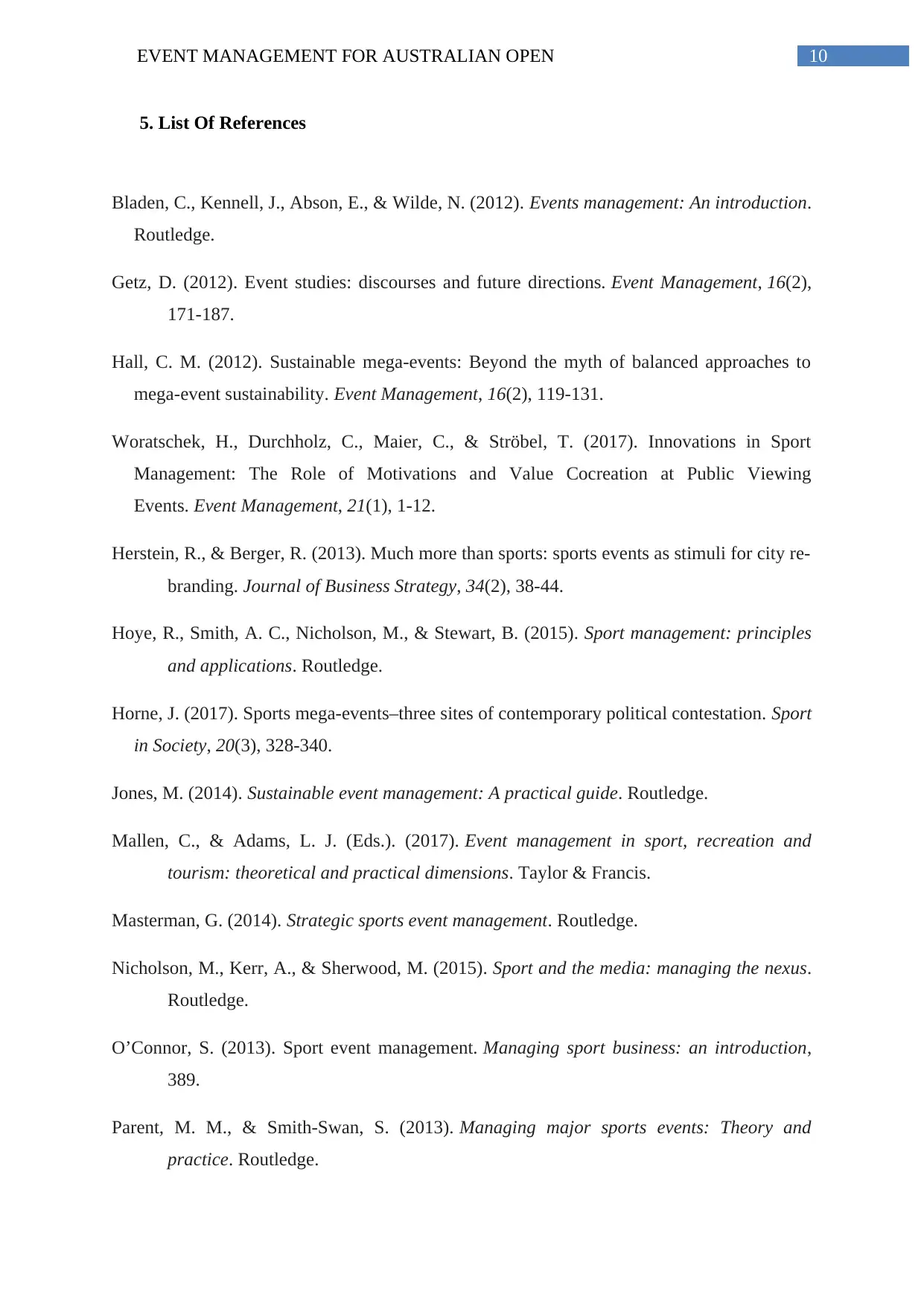
10EVENT MANAGEMENT FOR AUSTRALIAN OPEN
5. List Of References
Bladen, C., Kennell, J., Abson, E., & Wilde, N. (2012). Events management: An introduction.
Routledge.
Getz, D. (2012). Event studies: discourses and future directions. Event Management, 16(2),
171-187.
Hall, C. M. (2012). Sustainable mega-events: Beyond the myth of balanced approaches to
mega-event sustainability. Event Management, 16(2), 119-131.
Woratschek, H., Durchholz, C., Maier, C., & Ströbel, T. (2017). Innovations in Sport
Management: The Role of Motivations and Value Cocreation at Public Viewing
Events. Event Management, 21(1), 1-12.
Herstein, R., & Berger, R. (2013). Much more than sports: sports events as stimuli for city re-
branding. Journal of Business Strategy, 34(2), 38-44.
Hoye, R., Smith, A. C., Nicholson, M., & Stewart, B. (2015). Sport management: principles
and applications. Routledge.
Horne, J. (2017). Sports mega-events–three sites of contemporary political contestation. Sport
in Society, 20(3), 328-340.
Jones, M. (2014). Sustainable event management: A practical guide. Routledge.
Mallen, C., & Adams, L. J. (Eds.). (2017). Event management in sport, recreation and
tourism: theoretical and practical dimensions. Taylor & Francis.
Masterman, G. (2014). Strategic sports event management. Routledge.
Nicholson, M., Kerr, A., & Sherwood, M. (2015). Sport and the media: managing the nexus.
Routledge.
O’Connor, S. (2013). Sport event management. Managing sport business: an introduction,
389.
Parent, M. M., & Smith-Swan, S. (2013). Managing major sports events: Theory and
practice. Routledge.
5. List Of References
Bladen, C., Kennell, J., Abson, E., & Wilde, N. (2012). Events management: An introduction.
Routledge.
Getz, D. (2012). Event studies: discourses and future directions. Event Management, 16(2),
171-187.
Hall, C. M. (2012). Sustainable mega-events: Beyond the myth of balanced approaches to
mega-event sustainability. Event Management, 16(2), 119-131.
Woratschek, H., Durchholz, C., Maier, C., & Ströbel, T. (2017). Innovations in Sport
Management: The Role of Motivations and Value Cocreation at Public Viewing
Events. Event Management, 21(1), 1-12.
Herstein, R., & Berger, R. (2013). Much more than sports: sports events as stimuli for city re-
branding. Journal of Business Strategy, 34(2), 38-44.
Hoye, R., Smith, A. C., Nicholson, M., & Stewart, B. (2015). Sport management: principles
and applications. Routledge.
Horne, J. (2017). Sports mega-events–three sites of contemporary political contestation. Sport
in Society, 20(3), 328-340.
Jones, M. (2014). Sustainable event management: A practical guide. Routledge.
Mallen, C., & Adams, L. J. (Eds.). (2017). Event management in sport, recreation and
tourism: theoretical and practical dimensions. Taylor & Francis.
Masterman, G. (2014). Strategic sports event management. Routledge.
Nicholson, M., Kerr, A., & Sherwood, M. (2015). Sport and the media: managing the nexus.
Routledge.
O’Connor, S. (2013). Sport event management. Managing sport business: an introduction,
389.
Parent, M. M., & Smith-Swan, S. (2013). Managing major sports events: Theory and
practice. Routledge.
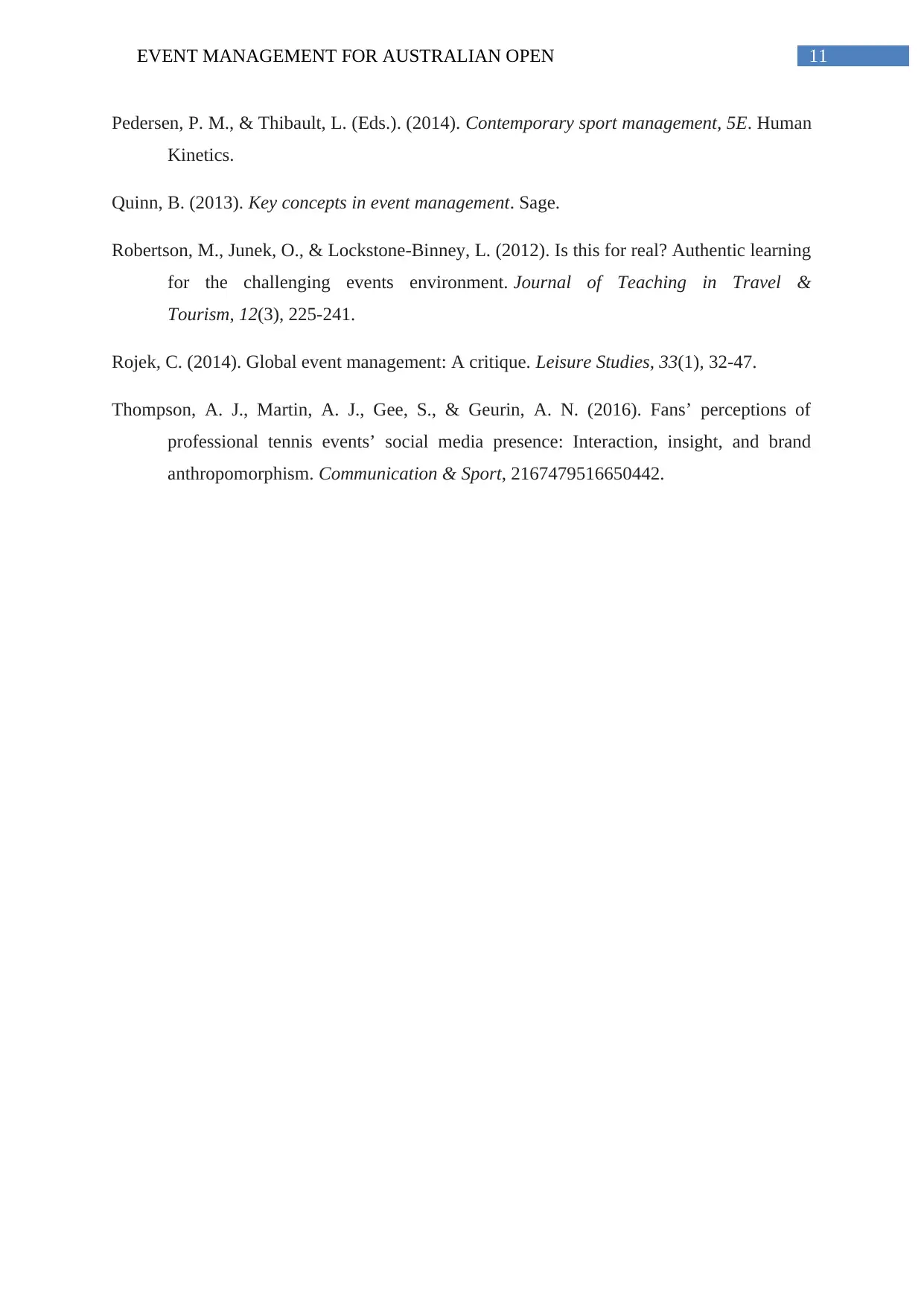
11EVENT MANAGEMENT FOR AUSTRALIAN OPEN
Pedersen, P. M., & Thibault, L. (Eds.). (2014). Contemporary sport management, 5E. Human
Kinetics.
Quinn, B. (2013). Key concepts in event management. Sage.
Robertson, M., Junek, O., & Lockstone-Binney, L. (2012). Is this for real? Authentic learning
for the challenging events environment. Journal of Teaching in Travel &
Tourism, 12(3), 225-241.
Rojek, C. (2014). Global event management: A critique. Leisure Studies, 33(1), 32-47.
Thompson, A. J., Martin, A. J., Gee, S., & Geurin, A. N. (2016). Fans’ perceptions of
professional tennis events’ social media presence: Interaction, insight, and brand
anthropomorphism. Communication & Sport, 2167479516650442.
Pedersen, P. M., & Thibault, L. (Eds.). (2014). Contemporary sport management, 5E. Human
Kinetics.
Quinn, B. (2013). Key concepts in event management. Sage.
Robertson, M., Junek, O., & Lockstone-Binney, L. (2012). Is this for real? Authentic learning
for the challenging events environment. Journal of Teaching in Travel &
Tourism, 12(3), 225-241.
Rojek, C. (2014). Global event management: A critique. Leisure Studies, 33(1), 32-47.
Thompson, A. J., Martin, A. J., Gee, S., & Geurin, A. N. (2016). Fans’ perceptions of
professional tennis events’ social media presence: Interaction, insight, and brand
anthropomorphism. Communication & Sport, 2167479516650442.
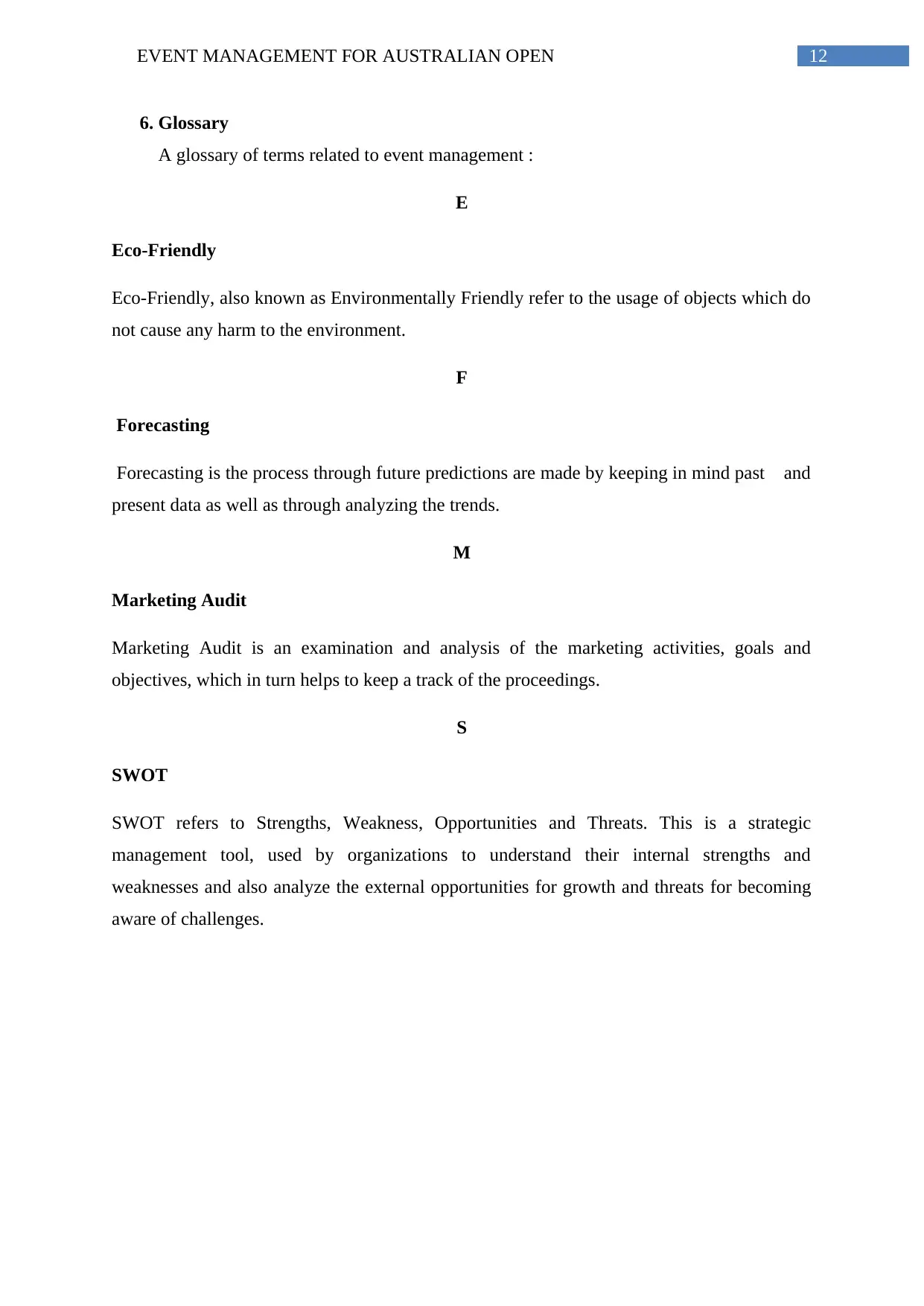
12EVENT MANAGEMENT FOR AUSTRALIAN OPEN
6. Glossary
A glossary of terms related to event management :
E
Eco-Friendly
Eco-Friendly, also known as Environmentally Friendly refer to the usage of objects which do
not cause any harm to the environment.
F
Forecasting
Forecasting is the process through future predictions are made by keeping in mind past and
present data as well as through analyzing the trends.
M
Marketing Audit
Marketing Audit is an examination and analysis of the marketing activities, goals and
objectives, which in turn helps to keep a track of the proceedings.
S
SWOT
SWOT refers to Strengths, Weakness, Opportunities and Threats. This is a strategic
management tool, used by organizations to understand their internal strengths and
weaknesses and also analyze the external opportunities for growth and threats for becoming
aware of challenges.
6. Glossary
A glossary of terms related to event management :
E
Eco-Friendly
Eco-Friendly, also known as Environmentally Friendly refer to the usage of objects which do
not cause any harm to the environment.
F
Forecasting
Forecasting is the process through future predictions are made by keeping in mind past and
present data as well as through analyzing the trends.
M
Marketing Audit
Marketing Audit is an examination and analysis of the marketing activities, goals and
objectives, which in turn helps to keep a track of the proceedings.
S
SWOT
SWOT refers to Strengths, Weakness, Opportunities and Threats. This is a strategic
management tool, used by organizations to understand their internal strengths and
weaknesses and also analyze the external opportunities for growth and threats for becoming
aware of challenges.
Paraphrase This Document
Need a fresh take? Get an instant paraphrase of this document with our AI Paraphraser
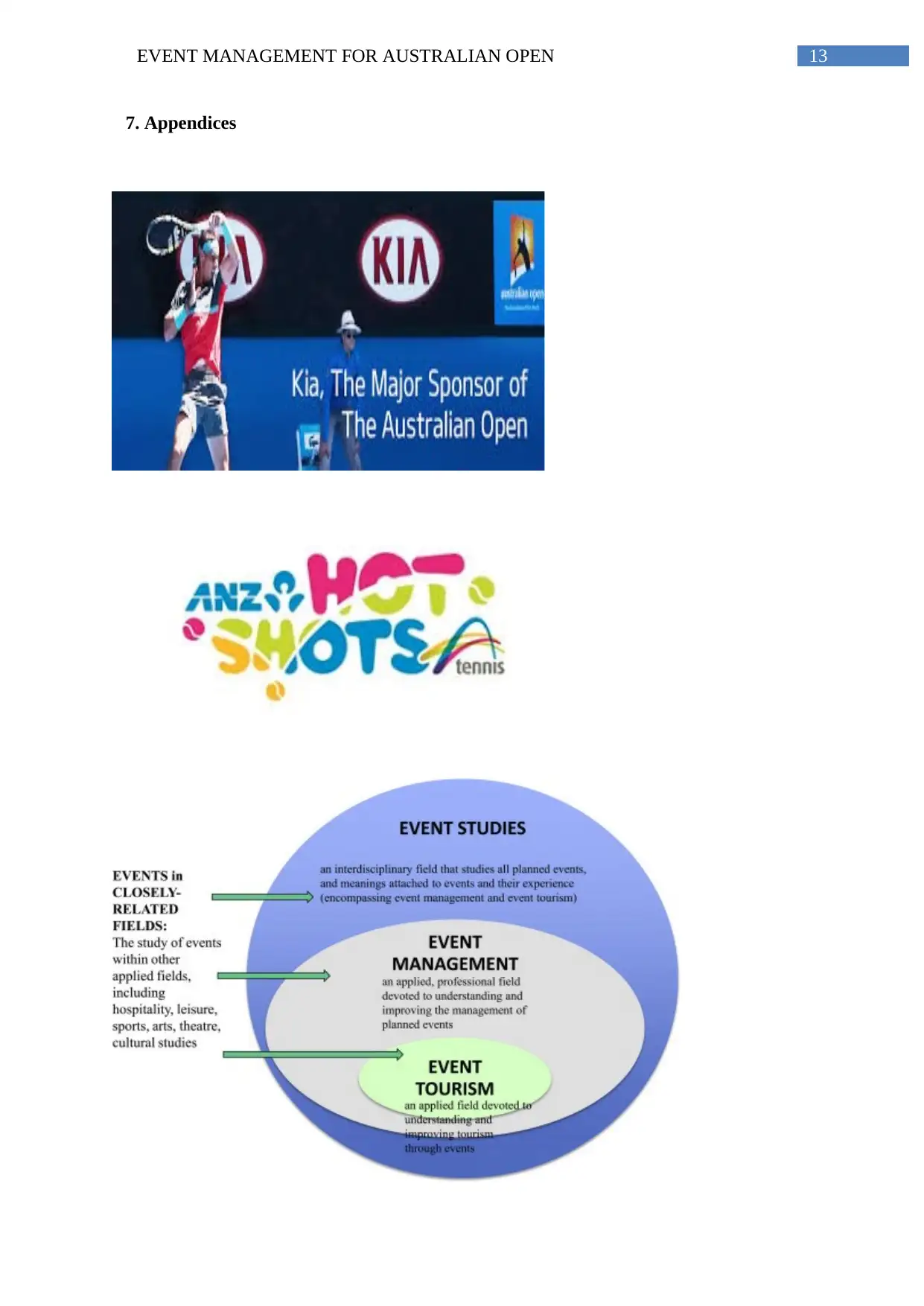
13EVENT MANAGEMENT FOR AUSTRALIAN OPEN
7. Appendices
7. Appendices

14EVENT MANAGEMENT FOR AUSTRALIAN OPEN
1 out of 15
Related Documents
Your All-in-One AI-Powered Toolkit for Academic Success.
+13062052269
info@desklib.com
Available 24*7 on WhatsApp / Email
![[object Object]](/_next/static/media/star-bottom.7253800d.svg)
Unlock your academic potential
© 2024 | Zucol Services PVT LTD | All rights reserved.




